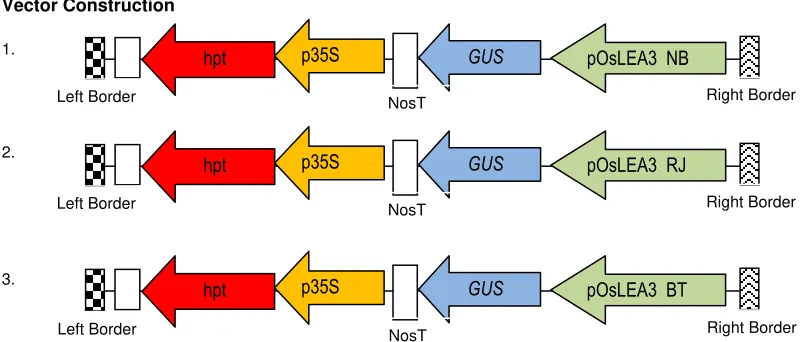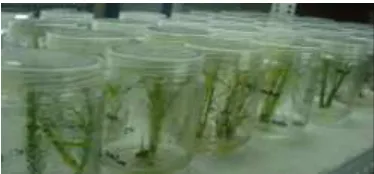Functional Analysis of Drought-Induced OsLEA3 Promoter
Isolated from Batutegi Rice Cultivar
Agus Rachmat
1, Satya Nugroho
1, Bernadetta Rina Hastilestari
1,
Kinasih Prayuni
1, Sudarsono
21.
Research Center For Biotechnology, Indonesian Institute of Sciences 2
Faculty of Agriculture,Bogor Agricultural University [email protected]
Abstract
Drought is the most significant environmental stress in agriculture and many efforts have been made to improve crop productivity under water-limiting conditions. Improving yield under drought is a major goal of plant breeding. Late embryogenesis abundant (LEA) proteins have been implicated in many stress responses of plants. It has been found that LEA genes are a gene family and play important roles in the protection of water stress. Expression of OsLEA3 is induced by abiotic stresses, including drought and high salinity. The promoter of OsLEA3 was cloned from Batutegi, Rojolele and Nipponbare cultivars and its function was analyzed in transgenic Nipponbare plant by a GUS reporter gene. Transient assay was conducted in order to investigate GUS expression driven by OsLEA3 promoter. OsLEA3 promoter was expressed in embryogenic callus indicated by the appearance of blue spots. Differences in color produced in embryogenic callus showed different expression level.
Key words: rice, drought, Batutegi, Rojolele, Nipponbare, GUS, OsLEA3 promoter
Introduction
Rice (Oryza sativa L.) is one of the major staple foods. As the population growth goes up, the rice production must be increased. However, the field for rice cultivation has decreased because of the change of paddy field into housing and industry. Moreover, drought influences the rice production especially in North China and South Asian. Thus, rice becomes one of the target source of gene and genome sequence analysis project among cereal plants (Goff et al. 2002).
δEA proteins constitute a large group of proteins that specifically expressed during seed development. LEA proteins are located in seeds and pollen. Many vegetative organs can also express some LEA proteins under conditions of dehydration, osmotic stress, cold or exogenous ABA. First δEA proteins were identified during the desiccation phases of seed development. These proteins were reported to protect specific cellular structures or ameliorate the effect of drought stress by sequestering ions and maintaining minimum cellular water requirements (Hu, 2008).
Materials and Methods
Promoter OsLEA3
Promoter sequence primers were designed based on sequence of genes LEA3 HVA-like gene promoter from rice cultivar IRAT 109 (GenBank Acc. DQ837728) and has been adapted to the BAC sequence of chromosome No. 5 rice cultivar Nipponbare (GenBank Acc. AC104713). Primer sequences are also designed to include the start codon (ATG) of mRNA sequences LEA3 gene (GenBank Acc. DQ789359) and the addition sequence EcoRI (G↓ AATTC) and BglII (A↓GATCT) in order to add EcoRI and BglII restriction sites in the primers. The predicted promoter was amplified and isolated by PCR. The amplified fragments were sequenced to ensure fidelity.
Isolation of rice genomic DNA
Isolation of genomic DNA of rice cv. Batutegi was conducted by CTAB method (Saghai-Maroof et al., 1984) that has been optimized. Rice leaf samples were taken from 1-month-old plants. A total of 2 g leaf samples were prepared using aluminum foil wrapping. Leaf powder was put into polypropylene tubes containing 10 ml of buffer solution which has been has been preheated in the incubator at 65oC for 30 minutes.
PCR analysis
All PCR reactions were done using 20 ng DNA template. PCR reaction mix contained 6.5 uδ nuclease free water, 12.5 uδ Green Go Taq 2x εaster, 2.5 uδ for each δEA F primer (0.1 ε) and δEA R (0.1 ε) promoter δEA3, and 1 l template DζA. PCR conditions wereμ initial denaturation 95oC for 3 minutes, followed by 35 cycles of denaturation at of 95oC for 1 minute, annealing at 60°C for 1 minute, and initial extention at 72oC for 1 minute. The cycle was terminated by final extention at 72oC for 10 minutes.
Vector Construction
Agrobacterium tumefaciens LBA4404 strain was transformed using recombinant plasmid pC1305 containing hygromycin phosphotransferase gene (hpt) controlled by CAMV 35S promoter, and GUS gene controlled by OsLEA3 promoter.
pOsLEA3 NB
GUS
hpt
Left Border NosT Right Border
pOsLEA3 RJ
GUS
hpt
p35S
Left Border NosT Right Border
pOsLEA3 BT
GUS
hpt
p35S
Left Border NosT Right Border
Histochemichal GUS assay
Water deficit treated and non treated plant tissues were vacuum infiltrated for 1 h in the GUS reaction mixture containing 1 mM 5-bromo-4-chloro-3-indolyl- b-D-glucuronide (X-gluc) and 50 mM sodium phosphate buffer and incubated at 37oC overnight. The reaction was stopped by adding 75% ethanol, and the pigments and chlorophylls were removed by repeated ethanol treatment.
Results and Discussion
Amplification of OsLEA3 promoter
Isolation of 1.291 bp OsLEA3 gene promoter was conducted by amplification of DNA genome using PCR with specific primers and visualized with 0.8% agarose gel (Figure 2). The PCR fragment was then cloned into pGEM-T Easy and then used to construct pC1305 based recombinant plasmid.
Figure 2. Amplification of OsLEA3 promoter.
Verification of the recombinant pGEM-T plasmid was conducted using EcoRI restriction analysis . The result showed 3 fragments, which were fragment with size 3.001 bp (pGEM-T Easy vector plasmid), 1.291 bp (gene OsLEA3 promoter), and 12 bp (nucleotides between EcoRI site of OsLEA promotor gene and EcoRI site of pGEM-T Easy) fragments (Figure 3).
Figure 3. Electrophoresis of recombinant vector digested with EcoRI.
Rice Transformation using Agrobacterium
Figure 4. Successfull transformed plant in the selection medium.
Some transformed calli survived in medium containing hygroimisin. Hygromisin resistant celli were subcultured to regeneration medium. Calli with green spot grew into planlets. Table 1 showed low transformation efficiency. It needs to be increased by optimizing conditions of the culture. Factors that influence the low efficieny of transfomation are method of tranformation, type of explants and condition of culture.
Table 1. Genetic transformation of OsLEA3 ::GUS to rice cv. Nipponbare
Histochemical Assay
Transient expression assaysof OsLEA3::GUS promoter of rice cv. Nipponbare, Rojolele and Batutegi were successfully conducted. GUS gene expression was identified with blue spot on the transformed calli .Figure 5 showed the difference intensity of blue spot in three cultivars. It means that the expression level of GUS gene differ among different OsLEA3 promoters. Real Time PCR will be conducted for further qualitative analysis.
Figure 5. Histochemical assay of transformed calli, NB= Niopponbare, RJ= Rojolele, BT= Batutegi.
Conclusion
1. Recombinant plasmid pCambia1305 of OsLEA3::GUS of Batutegi, Rojolele and Nipponbare cultivars was succesfully constructed.
2. Promoters OsLEA3 of Batutegi, Rojolele and Nipponbare cultivars controlled GUS expression differently among those cultivars
No Recombinant vectors Rice Varieties ∑ infected calli GUS assay
Number of Planlets
1. OsLEA3 NB::GUS Nipponbare 600 Positive 32
2. OsLEA3 Rj::GUS Nipponbare 600 Positive 19
References
Bray, E. A. 1993. Molecular response to water deficit. Plant Physiology 103: 1035-1040.
Gao, J-P., D-Y. Chao & H-X. Lin. 2007. Understanding abiotic stress tolerance mechanisms: Recent studies on stress response in rice. Journal of Integrative Plant Biology 49(6): 742--750.
Goff, S. A. et al. 2002. A draft sequence of rice genome (Oryza sativa L. ssp. Japonica). Science 296: 92--100.
Kalefetoğlu, T. & Y. Ekmekçi. 2005. The effects of drought on plants and tolerance mechanisms. Fen Bilimleri Dergisi 18(4): 723--740.
Promega. 2007. Technical manual pGEM-T and pGEM-T Easy vectorsystems. Promega Corporation, Madison: 1--28 hlm.
Spelundm, S., Aeboelarssen, S., Hughes, D.W., Galau, G.A.,Larsen, F., and Jakobsen, K.S., 1992. Late Embryo Genesis Abundant Genes Encoding Proteins with Different Numbers of Hydrophilic Repeats Are Regulated Differentially by Abscisic Acid and Osmotic Stress, Plant J. vol. 2, pp. 241–252.
Sambrook, J. & D.W. Russel. 2001. Molecular cloning: A laboratory manual, vol 1-3. 3rd ed. Cold Spring Harbor Laboratory Press, New York. 94 hlm.
Hu T. Z. 2008. OsLEA3, a Late Embryogenesis Abundant Protein Gene from Rice, Confers Tolerance to Water Deficit and Salt Stress to Transgenic Rice. Russian Journal of Plant Physiology, Vol. 55, No.4, pp. 530– 537.
Xiao, B., Y. Huang, N. Tang, & L. Xiong. 2007. Over-expression of a LEA gene in rice improves drought resistance under the field condition. Theory Application Genetics 115: 35--46.


